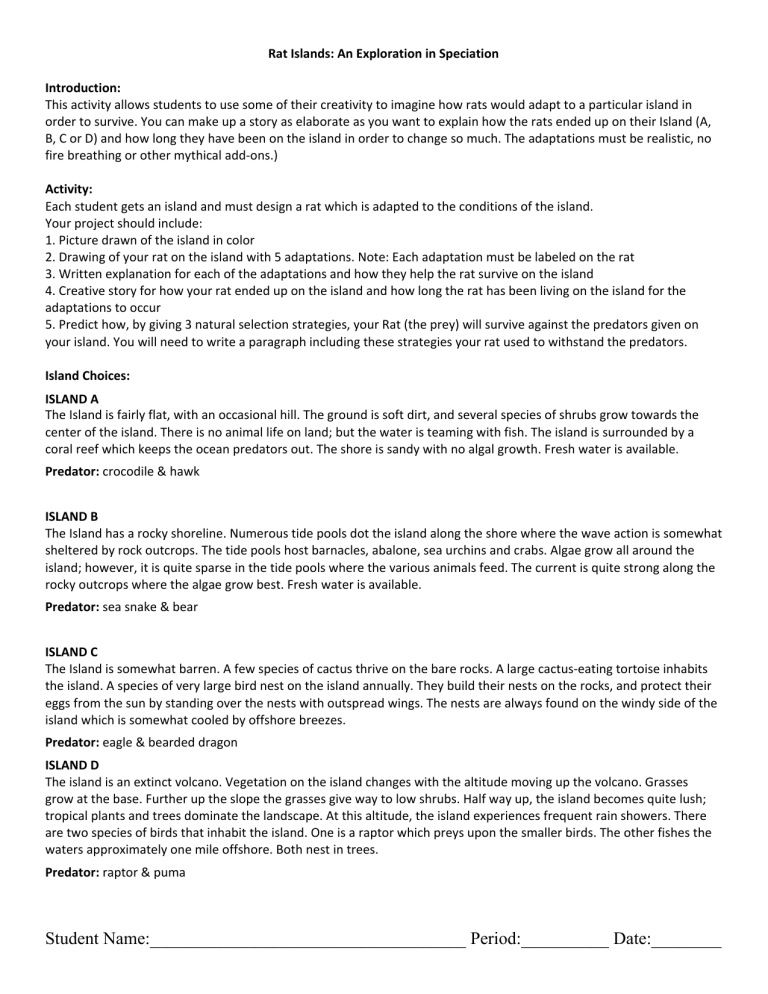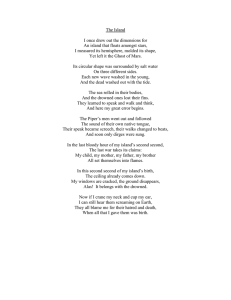
Rat Islands: An Exploration in Speciation Introduction: This activity allows students to use some of their creativity to imagine how rats would adapt to a particular island in order to survive. You can make up a story as elaborate as you want to explain how the rats ended up on their Island (A, B, C or D) and how long they have been on the island in order to change so much. The adaptations must be realistic, no fire breathing or other mythical add-ons.) Activity: Each student gets an island and must design a rat which is adapted to the conditions of the island. Your project should include: 1. Picture drawn of the island in color 2. Drawing of your rat on the island with 5 adaptations. Note: Each adaptation must be labeled on the rat 3. Written explanation for each of the adaptations and how they help the rat survive on the island 4. Creative story for how your rat ended up on the island and how long the rat has been living on the island for the adaptations to occur 5. Predict how, by giving 3 natural selection strategies, your Rat (the prey) will survive against the predators given on your island. You will need to write a paragraph including these strategies your rat used to withstand the predators. Island Choices: ISLAND A The Island is fairly flat, with an occasional hill. The ground is soft dirt, and several species of shrubs grow towards the center of the island. There is no animal life on land; but the water is teaming with fish. The island is surrounded by a coral reef which keeps the ocean predators out. The shore is sandy with no algal growth. Fresh water is available. Predator: crocodile & hawk ISLAND B The Island has a rocky shoreline. Numerous tide pools dot the island along the shore where the wave action is somewhat sheltered by rock outcrops. The tide pools host barnacles, abalone, sea urchins and crabs. Algae grow all around the island; however, it is quite sparse in the tide pools where the various animals feed. The current is quite strong along the rocky outcrops where the algae grow best. Fresh water is available. Predator: sea snake & bear ISLAND C The Island is somewhat barren. A few species of cactus thrive on the bare rocks. A large cactus-eating tortoise inhabits the island. A species of very large bird nest on the island annually. They build their nests on the rocks, and protect their eggs from the sun by standing over the nests with outspread wings. The nests are always found on the windy side of the island which is somewhat cooled by offshore breezes. Predator: eagle & bearded dragon ISLAND D The island is an extinct volcano. Vegetation on the island changes with the altitude moving up the volcano. Grasses grow at the base. Further up the slope the grasses give way to low shrubs. Half way up, the island becomes quite lush; tropical plants and trees dominate the landscape. At this altitude, the island experiences frequent rain showers. There are two species of birds that inhabit the island. One is a raptor which preys upon the smaller birds. The other fishes the waters approximately one mile offshore. Both nest in trees. Predator: raptor & puma Student Name:____________________________________ Period:__________ Date:________ Rat Island Rubric Island assigned:_________________ 1. Story is creative and contains information including: 10 points/__________ how the rat ended up on the island and how long it has been there 2. Drawing of island is neat and is in color:25 points/__________ Your drawing must include all the information given to you about the island. Label where necessary. 3. Drawing of rat is neat and in color: 10 points/__________ The drawing must be large enough to discern all 5 adaptations of the rat 4. Each adaptation is labeled (3 point each) 15 points/__________ 5. Each adaptation is explained (5 points each) 25 points/__________ 6. Paragraph on predation 15 points/ __________ Total points possible: 100 points/__________ Each drawing is to be done on a 8.5 x 11 sheet of white paper. Comments:



